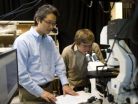(Press-News.org) New Rochelle, NY, January 4, 2011—Lowering the body temperature of patients soon after they have suffered a severe brain injury may reduce neurologic complications and improve outcomes. The safety of therapeutic hypothermia for traumatic brain injury (TBI) has been demonstrated in national studies. According to a Roundtable Discussion of renowned experts in the field, when and how it is administered should depend on the clinical condition of individual patients. The Roundtable was published online ahead of print in the new peer-reviewed journal Therapeutic Hypothermia and Temperature Management from Mary Ann Liebert, Inc. (www.liebertpub.com) that will launch officially in March 2011. The Roundtable is available at www.liebertpub.com/ther
Guy Clifton, MD, from the University of Texas Health Science Center at Houston, moderated the discussion on the "Future of Rewarming in Therapeutic Hypothermia for Traumatic Brain Injury: A Personalized Plan." He led an expert panel comprised of Alex Valadka, MD, from the Seton Brain and Spine Institute (Austin, TX), Imoigele Aisuku, MD, from the University of Texas Health Science Center, and David Okonkwo, MD, PhD, from the University of Pittsburgh Medical Center (PA), all of whom participated in the National Acute Brain Injury Study: Hypothermia II (NABISH II).
The panel concluded that factors such as the degree of body cooling, the duration of hypothermia, and the rate of rewarming need to be determined individually for each patient to maximize the effectiveness of the treatment and minimize the risk of complications. The successful transition of therapeutic hypothermia from a concept proven to be safe in human patients to an effective, widely used treatment strategy will require a better understanding of how the different types of TBI and the clinical condition of the patient affect the utility and risks of hypothermia.
"I think the readership of our new Journal will greatly appreciate the thoughtful comments made by this prestigious panel of experts concerning how best to use therapeutic hypothermia in this heterogeneous patient population," says Editor-in-Chief W. Dalton Dietrich, PhD, Kinetic Concepts Distinguished Chair in Neurosurgery, and Professor of Neurological Surgery, Neurology and Cell Biology and Anatomy at the University of Miami Leonard M. Miller School of Medicine.
INFORMATION:
Therapeutic Hypothermia and Temperature Management (www.liebertpub.com/ther) is a new quarterly, peer-reviewed journal published in print and online that covers all aspects of hypothermia and temperature control in the treatment of cardiac arrest, spinal cord and traumatic brain injury, stroke, myocardial ischemia, neurogenic fever, and other conditions. The Journal's distinguished multidisciplinary editorial board is led by Editor-in-Chief W. Dalton Dietrich, PhD; European Editor Hans Friberg, MD, PhD, Lund University (Sweden); and Australasian Editor Stephen Bernard, MD, The Alfred Hospital, Victoria, Australia.
Mary Ann Liebert, Inc. (www.liebertpub.com), is a privately held, fully integrated media company known for establishing authoritative peer-reviewed journals in many promising areas of science and biomedical research, including Journal of Neurotrauma. Its biotechnology trade magazine, Genetic Engineering & Biotechnology News (GEN), was the first in its field and is today the industry's most widely read publication worldwide. A complete list of the firm's 60 journals, books, and newsmagazines is available at www.liebertpub.com
Mary Ann Liebert, Inc. 140 Huguenot St., New Rochelle, NY 10801-5215 www.liebertpub.com
Phone: (914) 740-2100 (800) M-LIEBERT Fax: (914) 740-2101
Optimizing patient outcomes after therapeutic hypothermia for traumatic brain injury
2011-01-06
ELSE PRESS RELEASES FROM THIS DATE:
Pregnant, constipated and bloated? Fly poo may tell you why
2011-01-06
Clues about how the human gut helps regulate our appetite have come from a most unusual source – fruit fly faeces. Scientists at the University of Cambridge are using the fruit fly to help understand aspects of human metabolism, including why pregnant women suffer from bloating and constipation, and even the link between a low calorie diet and longevity.
Although scientists have known for some time that there are as many as 500 million nerve cells in our gut, the sheer complexity that this presents means that little is known about the different types of nerve cell and ...
MIT researchers study the danger of toxoplasma parasites
2011-01-06
CAMBRIDGE, Mass. -- About one-third of the human population is infected with a parasite called Toxoplasma gondii, but most of them don't know it. Though Toxoplasma causes no symptoms in most people, it can be harmful to individuals with suppressed immune systems, and to fetuses whose mothers become infected during pregnancy. Toxoplasma spores are found in dirt and easily infect farm animals such as cows, sheep, pigs and chickens. Humans can be infected by eating undercooked meat or unwashed vegetables.
Jeroen Saeij, an assistant professor of biology at MIT is investigating ...
Current smokers with early rheumatoid arthritis less responsive to TNF inhibitors, methotrexate
2011-01-06
Patients with early rheumatoid arthritis (RA) who are current smokers were less likely to achieve good response to methotrexate (MTX) and tumor necrosis factor (TNF) inhibitors than those who never smoked. The study by researchers from Sweden also found that RA patients who smoked in the past did not experience a lower response to these therapies. Results of the 10-year study appear in the January 2011 issue of Arthritis & Rheumatism, a journal published by Wiley-Blackwell on behalf of the American College of Rheumatology (ACR).
According to the World Health Organization ...
Accurate interpretation of antinuclear antibodies test key to confirming autoimmune disease
2011-01-06
The presence of antinuclear antibodies (ANA) indicates the possibility of autoimmunity and the indirect immunofluorescence (IIF) assay on HEp-2 cells is the standard blood test (ANA-HEp-2) used to detect ANA. However, studies have shown that a "false-positive" ANA test occurs in up to 13% of healthy individuals. In such cases the test detects the presence of autoantibodies that apparently are not associated with autoimmunity. Researchers from Brazil have now uncovered distinguishing characteristics of the ANA test in healthy individuals and patients with autoimmune disease, ...
Smithsonian instrument 'fills the gap,' views sun's innermost corona
2011-01-06
During a total eclipse of the Sun, skywatchers are awed by the shimmering corona -- a faint glow that surrounds the Sun like gossamer flower petals. This outer layer of the Sun's atmosphere is, paradoxically, hotter than the Sun's surface, but so tenuous that its light is overwhelmed by the much brighter solar disk. The corona becomes visible only when the Sun is blocked, which happens for just a few minutes during an eclipse.
Now, an instrument on board NASA's Solar Dynamics Observatory (SDO), developed by Smithsonian scientists, is giving unprecedented views of the ...
Clinical practitioners not adhering to evidence-based guidelines for osteoarthritis
2011-01-06
New research found clinicians who care for patients with osteoarthritis (OA) are likely not following standard care guidelines that are based on current medical evidence. Researchers noted physicians were prescribing medications for pain and inflammation, or opting for surgical interventions rather than recommending weight loss plans or exercise programs to OA patients. Details of the this study are available in the January 2011 issue of Arthritis Care & Research, a journal published by Wiley-Blackwell on behalf of the American College of Rheumatology.
A 2002 report ...
New solar cell self-repairs like natural plant systems
2011-01-06
WEST LAFAYETTE, Ind. - Researchers are creating a new type of solar cell designed to self-repair like natural photosynthetic systems in plants by using carbon nanotubes and DNA, an approach aimed at increasing service life and reducing cost.
"We've created artificial photosystems using optical nanomaterials to harvest solar energy that is converted to electrical power," said Jong Hyun Choi, an assistant professor of mechanical engineering at Purdue University.
The design exploits the unusual electrical properties of structures called single-wall carbon nanotubes, using ...
Wake up and smell the willow
2011-01-06
More plant matter could be burned in coal-fired power stations if this 'green' fuel was delivered pre-roasted like coffee beans, according to researchers from the University of Leeds, UK.
Many UK power stations are now burning plant matter, or biomass, as well as coal in a bid to cut their carbon footprint. Unlike fossil fuels, plants like willow, Miscanthus and poplar are a virtually carbon-neutral source of energy: the carbon dioxide emitted when they burn is absorbed during photosynthesis by the next batch of 'energy crops' planted in their place.
But the environmental ...
US does not have infrastructure to consume more ethanol
2011-01-06
WEST LAFAYETTE, Ind. - The United States doesn't have the infrastructure to meet the federal mandate for renewable fuel use with ethanol but could meet the standard with significant increases in cellulosic and next-generation biofuels, according to a Purdue University study.
Wally Tyner, the James and Lois Ackerman Professor of Agricultural Economics, and co-authors Frank Dooley, a Purdue professor of agricultural economics, and Daniela Viteri, a former Purdue graduate student, used U.S. Department of Energy and Environmental Protection Agency data to determine that the ...
Environmental Science & Technology special issue on environmental policy now online
2011-01-06
WASHINGTON, Jan. 4, 2011 — A special edition of the American Chemical Society journal, Environmental Science & Technology (ES&T), one of the world's premier environmental journals, is available now for a limited time online without charge. The special edition will be accessible free during 2011, when the world celebrates the International Year of Chemistry.
Entitled "Environmental Policy: Past, Present, and Future," the special issue of ES&T recognizes closure of a "green" decade in which people became more aware of environmental issues, and society marked the 40th anniversaries ...




